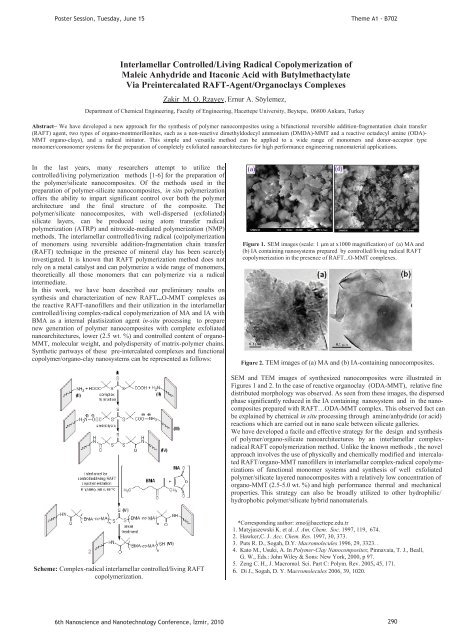Photonic crystals in biology
Photonic crystals in biology
Photonic crystals in biology
You also want an ePaper? Increase the reach of your titles
YUMPU automatically turns print PDFs into web optimized ePapers that Google loves.
Poster Session, Tuesday, June 15<br />
Theme A1 - B702<br />
Interlamellar Controlled/Liv<strong>in</strong>g Radical Copolymerization of<br />
Maleic Anhydride and Itaconic Acid with Butylmethactylate<br />
Via Pre<strong>in</strong>tercalated RAFT-Agent/Organoclays Complexes<br />
Zakir M. O. Rzayev, Ernur A. Söylemez,<br />
Department of Chemical Eng<strong>in</strong>eer<strong>in</strong>g, Faculty of Eng<strong>in</strong>eer<strong>in</strong>g, Hacettepe University, Beytepe, 06800 Ankara, Turkey<br />
Abstract– We have developed a new approach for the synthesis of polymer nanocomposites us<strong>in</strong>g a bifunctional reversible addition-fragmentation cha<strong>in</strong> transfer<br />
(RAFT) agent, two types of organo-montmorillonites, such as a non-reactive dimethyldodecyl ammonium (DMDA)-MMT and a reactive octadecyl am<strong>in</strong>e (ODA)-<br />
MMT organo-clays), and a radical <strong>in</strong>itiator. This simple and versatile method can be applied to a wide range of monomers and donor-acceptor type<br />
monomer/comonomer systems for the preparation of completely exfoliated nanoarchitectures for high performance eng<strong>in</strong>eer<strong>in</strong>g nanomaterial applications.<br />
In the last years, many researchers attempt to utilize the<br />
controlled/liv<strong>in</strong>g polymerization methods [1-6] for the preparation of<br />
the polymer/silicate nanocomposites. Of the methods used <strong>in</strong> the<br />
preparation of polymer-silicate nanocomposites, <strong>in</strong> situ polymerization<br />
offers the ability to impart significant control over both the polymer<br />
architecture and the f<strong>in</strong>al structure of the composite. The<br />
polymer/silicate nanocomposites, with well-dispersed (exfoliated)<br />
silicate layers, can be produced us<strong>in</strong>g atom transfer radical<br />
polymerization (ATRP) and nitroxide-mediated polymerization (NMP)<br />
methods. The <strong>in</strong>terlamellar controlled/liv<strong>in</strong>g radical (co)polymerization<br />
of monomers us<strong>in</strong>g reversible addition-fragmentation cha<strong>in</strong> transfer<br />
(RAFT) technique <strong>in</strong> the presence of m<strong>in</strong>eral clay has been scarcely<br />
<strong>in</strong>vestigated. It is known that RAFT polymerization method does not<br />
rely on a metal catalyst and can polymerize a wide range of monomers,<br />
theoretically all those monomers that can polymerize via a radical<br />
<strong>in</strong>termediate.<br />
In this work, we have been described our prelim<strong>in</strong>ary results on<br />
synthesis and characterization of new RAFT...O-MMT complexes as<br />
the reactive RAFT-nanofillers and their utilization <strong>in</strong> the <strong>in</strong>terlamellar<br />
controlled/liv<strong>in</strong>g complex-radical copolymerization of MA and IA with<br />
BMA as a <strong>in</strong>ternal plastisization agent <strong>in</strong>-situ process<strong>in</strong>g to prepare<br />
new generation of polymer nanocomposites with complete exfoliated<br />
nanoarchitectures, lower (2.5 wt. %) and controlled content of organo-<br />
MMT, molecular weight, and polydispersity of matrix-polymer cha<strong>in</strong>s.<br />
Synthetic partways of these pre-<strong>in</strong>tercalated complexes and functional<br />
copolymer/organo-clay nanosystems can be represented as follows:<br />
Figure 1. SEM images (scale: 1 m at x1000 magnification) of (a) MA and<br />
(b) IA conta<strong>in</strong><strong>in</strong>g nanosystems prepared by controlled/liv<strong>in</strong>g radical RAFT<br />
copolymerization <strong>in</strong> the presence of RAFT...O-MMT complexes.<br />
Figure 2. TEM images of (a) MA and (b) IA-conta<strong>in</strong><strong>in</strong>g nanocomposites.<br />
SEM and TEM images of synthesized nanocomposites were illustrated <strong>in</strong><br />
Figures 1 and 2. In the case of reactive organoclay (ODA-MMT), relative f<strong>in</strong>e<br />
distributed morphology was observed. As seen from these images, the dispersed<br />
phase significantly reduced <strong>in</strong> the IA conta<strong>in</strong><strong>in</strong>g nanosystem and <strong>in</strong> the nanocomposites<br />
prepared with RAFT…ODA-MMT complex. This observed fact can<br />
be expla<strong>in</strong>ed by chemical <strong>in</strong> situ process<strong>in</strong>g through am<strong>in</strong>e/anhydride (or acid)<br />
reactions which are carried out <strong>in</strong> nano scale between silicate galleries.<br />
We have developed a facile and effective strategy for the design and synthesis<br />
of polymer/organo-silicate nanoarchitectures by an <strong>in</strong>terlamellar complexradical<br />
RAFT copolymerization method. Unlike the known methods , the novel<br />
approach <strong>in</strong>volves the use of physically and chemically modified and <strong>in</strong>tercalated<br />
RAFT/organo-MMT nanofillers <strong>in</strong> <strong>in</strong>terlamellar complex-radical copolymerizations<br />
of functional monomer systems and synthesis of well exfoliated<br />
polymer/silicate layered nanocomposites with a relatively low concentration of<br />
organo-MMT (2.5-5.0 wt. %) and high performance thermal and mechanical<br />
properties. This strategy can also be broadly utilized to other hydrophilic/<br />
hydrophobic polymer/silicate hybrid nanomaterials.<br />
Scheme: Complex-radical <strong>in</strong>terlamellar controlled/liv<strong>in</strong>g RAFT<br />
copolymerization.<br />
*Correspond<strong>in</strong>g author: zmo@hacettepe.edu.tr<br />
1. Matyjaszewski K. et al. J. Am. Chem. Soc. 1997, 119, 674.<br />
2. Hawker,C. J. Acc. Chem. Res. 1997, 30, 373.<br />
3. Puts R. D., Sogah, D.Y. Macromolecules 1996, 29, 3323. .<br />
4. Kato M., Usuki, A. In Polymer-Clay Nanocomposites; P<strong>in</strong>navaia, T. J., Beall,<br />
G. W., Eds.: John Wiley & Sons: New York, 2000, p 97.<br />
5. Zeng C. H., J. Macromol. Sci. Part C: Polym. Rev. 2005, 45, 171.<br />
6. Di J., Sogah, D. Y. Macromolecules 2006, 39, 1020.<br />
6th Nanoscience and Nanotechnology Conference, zmir, 2010 290













